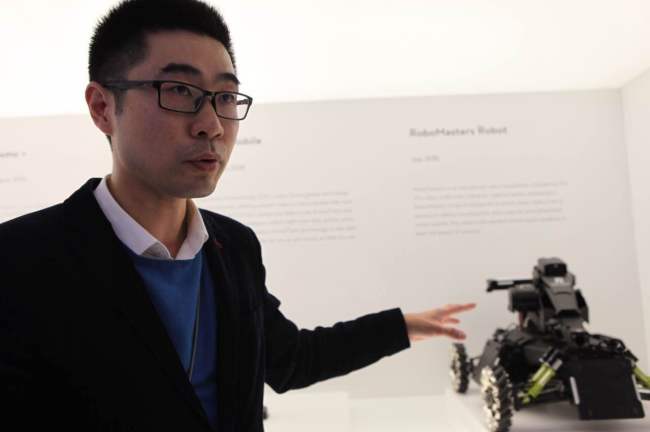[FROM THE SCENE] DJI eyes rapid growth with drones, robots
By Park Ga-youngPublished : Dec. 6, 2016 - 17:43
The Korea Herald is publishing a series of articles on the moves made by the companies and governments of South Korea, China and Japan in entering the new industry 4.0 era. This is the second installment. -- Ed.

Shenzhen, CHINA -- “This is the future of our company and something China will be really proud of,” Wang Fan, communications director at the world’s biggest drone maker, Dajiang Innovation Technology Co., said in front of a displayed product. And it wasn’t a drone.
A robot was revealed by the Shenzhen company, which has become a world leading drone maker within a decade since its launch.
The displayed robot is one of the robots used by college teams competing in RoboMasters, an annual robot competition DJI pours 50 million yuan ($6.68 million) into hosting every year. The robot can shoot plastic balls, detect incoming hits, and use a special omni-directional wheel system.
The purpose of the competition is to hire young Chinese talent as well as to get ahead in the fast expanding robot industry.
“We want to continue to do what we do well, something like a combination of a drone and a robot,” Wang said.
A tour of the company headquarters in Nanshan District in Shenzhen, China on Nov. 10, took place on the 14th floor, the only space open to the public, out of 10 floors the company occupies in the building.
“We have another office in the city as we’re rapidly expanding,” said Wang.
The company indeed has seen explosive growth in the past 10 years. Wang Tao, 36, was a model airplane enthusiast as a child and founded the company in 2006, which was an extension of his passion for flying objects. Back then there were a mere 20 employees, a number that has now ballooned to 6,000.
DJI’s sales were 3 million yuan in 2010 but in four years skyrocketed to 2.8 billion yuan. In 2015, the company achieved $1 billion sales, a first for a drone company.
As of 2015, the company occupied 70 percent of the $1.4 billion drone market.
The growth has made the founder one of the richest men in China.
With a fortune of 24 billion yuan, Wang is now the second richest post-80s self-made billionaire in China, according to a Hurun report on Oct. 31. He is also ranked 77th on the 2016 China Rich List.
Behind flying success
Behind the success is the company’s devotion to research and development, according to the company.
“We are crazy about technologies,” communications director Wang said. When asked about the size of the company’s R&D budget, his answer was “limitless.”
“If an employee needs a new computer every day for research, it would not be a problem,” he said.
Currently, one-fourth of the company’s employees work in R&D.

Wang Fan emphasized that the fact the company was based in Shenzhen played a significant role. So significant that “if DJI were founded somewhere else, it would have been impossible for us to get to where we are -- even in Silicon Valley it would have been impossible,” Wang said.
Shenzhen, a city of 7 million, is located next to Hong Kong and is the headquarters of companies like Huawei, the telecommunication equipment giant, and Tencent, one of China’s largest tech firms that operates WeChat, a mobile messenger app with 840 million active users every month.
The city, which has lax regulations and a hub for hardware, is now home to 300 drone companies -- something DJI calls the ‘DJI effect.’
Koo Hyuck-chae, director of creative economy planning division at the Korean Ministry of Science, ICT and Future Planning acknowledged that lax regulations in Shenzhen might have given birth to a company like DJI.
“Companies like DJI probably conducted countless tests, flying their drones in the sky but it is really difficult in South Korea where many regulations prevent innovative companies from trying things out,” Koo said.
Korean market
DJI in March opened their first-ever overseas flagship store in South Korea, hoping the drone maker specialized in taking photos and videos could grab South Korea’s burgeoning entertainment industry.
The company found one interesting factor about South Korean customers -- elderly people.
“There are many elderly people who visit the flagship store in Seoul and they find drones really interesting and take it as a new pleasure in their lives,” Wang Fan said.
Such keen attention is similar to what made DJI’s operation in the US fruitful. DJI took its first Phantom drone in 2012 to Hollywood and showed it to producers like James Cameron. And from there Phantom appeared on US TV shows like Big Bang Theory.
Now a number of Korean TV shows, which are often exported to other Asian countries, feature drones and use drones in the production.
It is estimated that there are 300 drone companies in Shenzhen alone and another 300 outside China. The French drone maker Parrot and US firm GoPro and Chinese rivals such as eHang and Xiaomi are some of the competitors in the global market.
DJI expressed confidence in the intensifying rivalry.
“To be honest, I’ve never heard of any Japanese drone company…But Japan has high technologies in many areas that it can also become successful in drone making,” Wang said when asked about his thoughts on drones made in Japan.
“The threshold in the drone industry is so much higher than other industries,” Wang said.
By Park Ga-young (gypark@heraldcorp.com)












![[Today’s K-pop] BTS pop-up event to come to Seoul](http://res.heraldm.com/phpwas/restmb_idxmake.php?idx=644&simg=/content/image/2024/04/17/20240417050734_0.jpg&u=)





![[KH Explains] Hyundai's full hybrid edge to pay off amid slow transition to pure EVs](http://res.heraldm.com/phpwas/restmb_idxmake.php?idx=652&simg=/content/image/2024/04/18/20240418050645_0.jpg&u=20240419100350)

